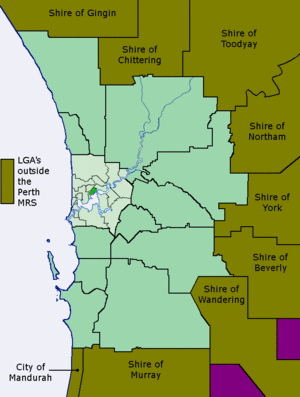Metropolitan Region Scheme facts for kids
The Metropolitan Region Scheme (MRS) is a special plan for how land is used in the Perth metropolitan region. Think of it like a big map that decides what different areas can be used for. It helps manage how Perth grows and develops.
The MRS divides land into different areas, like zones for homes, businesses, or parks. It also sets aside land for future roads or nature areas. The Western Australian Planning Commission (WAPC) is in charge of this plan. The MRS is one of three similar plans in Western Australia.
The plan is always being updated. Changes are made based on new ideas and strategies from the Department of Planning, Lands and Heritage. Local councils also make their own smaller plans. These smaller plans must follow the rules of the MRS. The WAPC must approve them.
Land needed for public things, like parks or roads, is bought using a special tax. This tax is called the Metropolitan Region Improvement Tax.
What is the MRS?
The MRS started from a plan made in 1955 by Hepburn and Stephenson. It has been helping to guide Perth's growth since 1963. The government asked Hepburn and Stephenson to create this plan in 1953.
Their report suggested setting up a group to put the plan into action. This idea became law in 1959. This law gave the state government control over dividing land into smaller blocks. But it also let local councils handle many local planning tasks.
How the MRS Changes
Since 1963, the MRS has been updated many times. These updates change how land is zoned or reserved. This allows for new ways to use the land.
These changes are often based on big regional plans made over time. These plans include:
- The 1955 Plan
- The Corridor Plan in 1970
- The Metroplan of 1990
- Directions 2031 in 2010
In 2006, a new law called the Planning and Development Act 2005 came out. This law replaced the old one from 1959. It also allowed new regional plans to be made outside the Perth area.
Funding the MRS
The Metropolitan Region Scheme gets its money from a special tax. This tax is called the Metropolitan Region Improvement Tax (MRIT). Gordon Stephenson's report first suggested this tax. It started in 1959.
The MRIT is a tax on the value of land that is worth more than $300,000. Your main home is not included in this tax. The Department of Finance collects the tax. But the Western Australian Planning Commission (WAPC) controls how the money is used.
This tax money helps buy land for public use. This includes land for:
- Public parks and open spaces
- New roads and railway lines
- Protecting the environment
It is estimated that the MRIT has paid for over $1 billion worth of land since 1963. This amount is not adjusted for inflation.
The MRIT only applies to the MRS area. It does not apply to other regional plans like the Peel Region Scheme. Land for these other schemes is bought with money from the state government's yearly budget.


